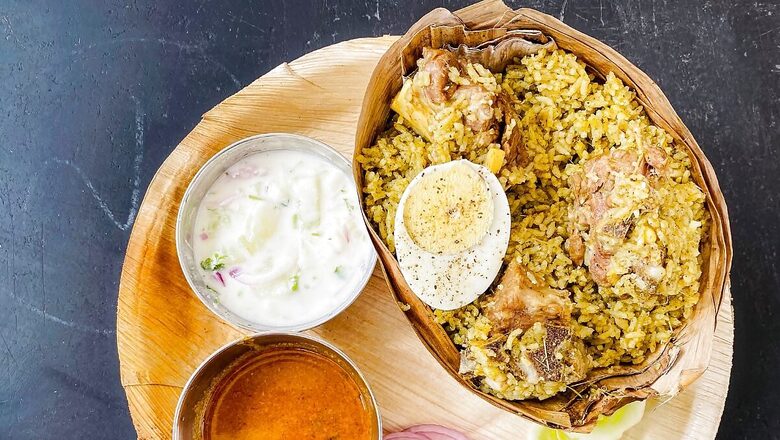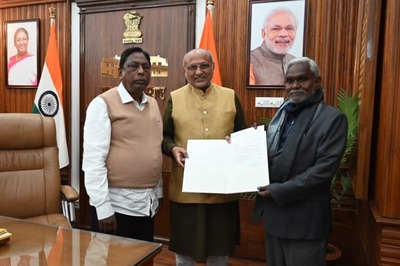
views
I was in Bengaluru recently to shoot an episode of a food show on my YouTube channel ‘Khaane Mein Kya Hai’. My guest was the exuberant and unstoppable, Sudha Murthy. We both chatted nineteen to a dozen, an exhilarating conversation while eating a pure Sattvic meal served on a banana leaf. This was at a lovely little place called at By2 Coffee in Bengaluru’s Basavanagudi.
This simple meal consisting of freshly cooked Peanut Kosambari, (a salad of carrots and peanuts), Palya, a crunch vegetable preparation, lightly fried vegetables and greens, along with spices, with Tendli, and it was just delicious. All served with Akki Roti, Chutney, Bajji made of plump chillies, with Rice, Rasam and Sambhar. Their specialty, however, was Holige, which is a sweet stuffed flatbread made with chana dal, jaggery, cardamom and flour, in short, it is the Kannada version of the Maharashtra’s Puran Poli.
So familiar was the taste of Holige to my Maharashtrian palate that I began to wonder how strong was the Maratha influence on the food in Karnataka after Shahaji Bhonsle took over Bangalore in 1638, and hundreds from his military settled here and made this land their home.
And the strongest apparent influence of Maratha cuisine can be found in small eateries often called ‘military hotels’ still run by Kannadigas of Maratha origin. These are simple, middle-class joints, which serve rows of hungry customers the Maratha influenced delicacies, especially non-vegetarian food. Again all simply served on a banana leaf.
You would find most of these military hotels in the older parts of Bengaluru. They say these military hotels were the first to serve non-vegetarian food. Some of them even clearly mentioned the word “Hindu” in their names only to clarify that although they were non-vegetarian places serving chicken and mutton, they did not serve any pork or beef.
I landed up at one of these military hotels. It was aptly called “Shivaji Military Hotel” with a big portrait of Chhatrapati Shivaji Maharaj emblazoned on the sign board. This is quite a historical restaurant. Shivaji Military Hotel was started in 1924 by a Maratha named S Mannaji Rao.
Shivaji Military Hotel is one of the oldest military hotels, and is known for its non-vegetarian food. The Keema curry that they serve is a spicy dark brown mutton mince preparation, which according to me, tastes best with idlis. A peppery mutton fry that will awaken your taste buds. Of course, the most iconic dish being the ‘Donne Biryani’. Legend says the recipe for the ‘Donne Biryani’ can be traced back to the 17th Century, when India was struggling through wars. And any war means that thousands of hungry soldiers have to be fed a wholesome meal of proteins and carbohydrates. What better combination of protein and carbohydrates than a biryani. So, from the war kitchens of the Marathas came the now famous ‘Donne Biryani’. Short-grained rice, cooked with marinated meat in ginger and garlic, and spices like coriander, cumin, and garam masala. This was slow-cooked on firewood and then stored and served in cups made from leaves, which in Marathi is called “Drons” from where I am assuming the word “Donne” comes. The leaves add their own flavour and character to the biryani, and it is unlike any Mughlai Biryani you may have eaten.
The meat is tender and soft, mildly spiced and the rice with a pre-dominant flavour of green chillies and pepper, and finished off with smoky ghee. Along with the Donne Biryani, I ordered the Mutton Dry, Mutton Keema and the Mutton Liver. I have eaten enough South Indian food to know that while these dishes were robust with spices, the spice-mixes used was closer in taste to those spices from parts of Kolhapur and Satara, yet with a strong Kannadiga influence. I also ordered dosa, homestyle, soft and slightly sour, which according to me went superbly with the gravies. I needed that dosa because after all I hate mixing my gravies with Biryani. All in all, this was a spectacular meal and an eye opening cuisine. It just reinforced what I always think, that food from India will never stop surprising you.
Kunal Vijayakar is a food writer based in Mumbai. He tweets @kunalvijayakar and can be followed on Instagram @kunalvijayakar. His YouTube channel is called Khaane Mein Kya Hai. The views expressed in this article are those of the author and do not represent the stand of this publication.



















Comments
0 comment